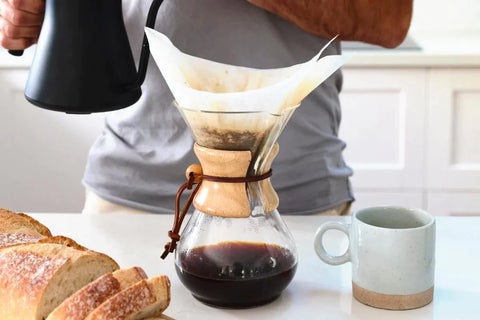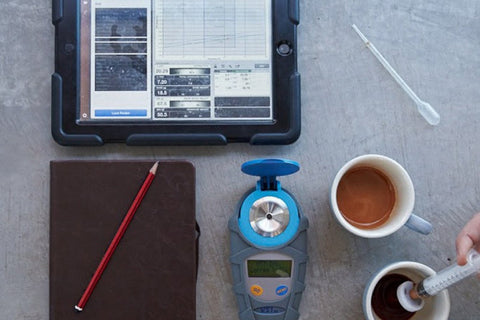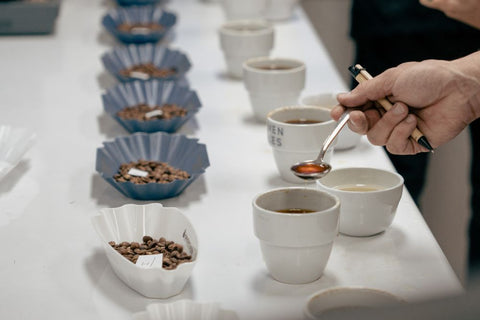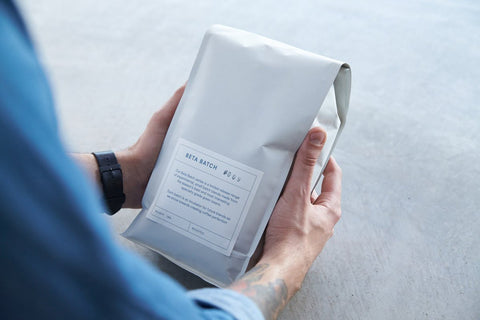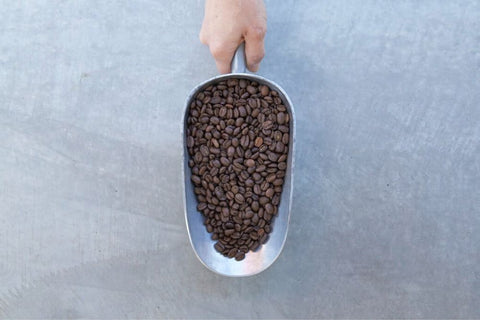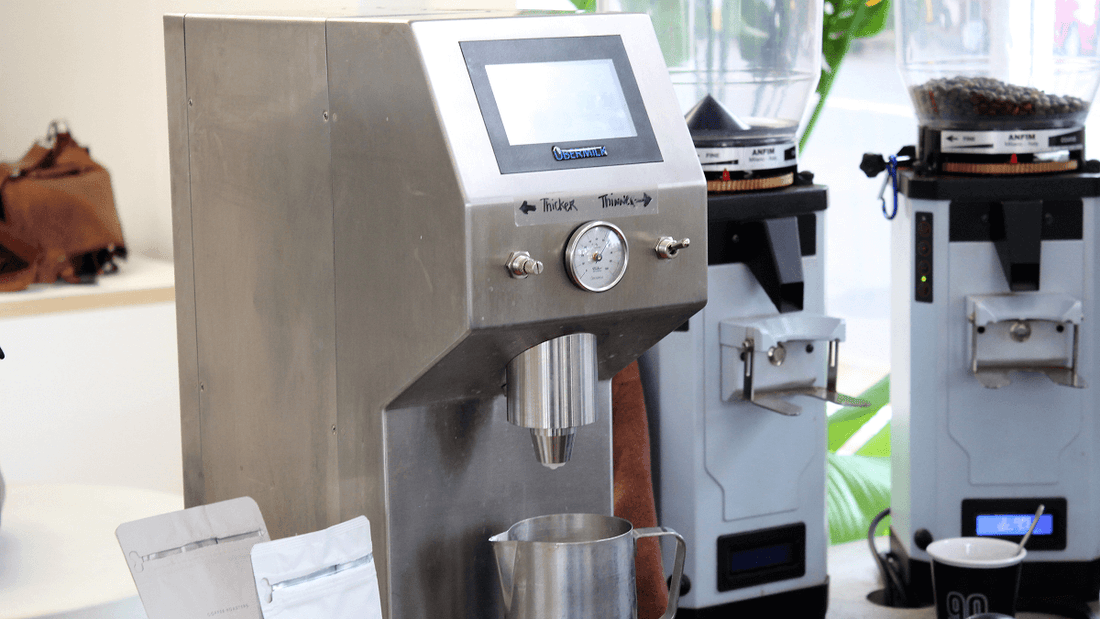Automation in cafes is on the rise, with commercially available technologies like automatic dosing grinders , Puqpress and espresso machines that control brew ratios all making their mark.
One of the newer innovations that will start popping up in Australian cafes over the next year will be the Ubermilk unit. Here’s what we learned after running some real-world tests on it over the last 2 weeks.
Uber-what?
The Ubermilk is a foamed-milk dispenser. That is, you press a button and out comes steamed milk, ready to pour.
A rough diagram of how the unit works is shown in Figure 1. The Ubermilk accurately meters milk volumes through an aerator valve, rapidly heats the milk to the specified temperature, and delivers reproducibly foamed milk through a micron-perforated filtration unit. The system produces foam that is highly stable, with a surprisingly silky texture. It differs from previous units in that the milk is aerated cold, and subsequently heated. Older methods tend to do this foam-heat process in the reverse order. 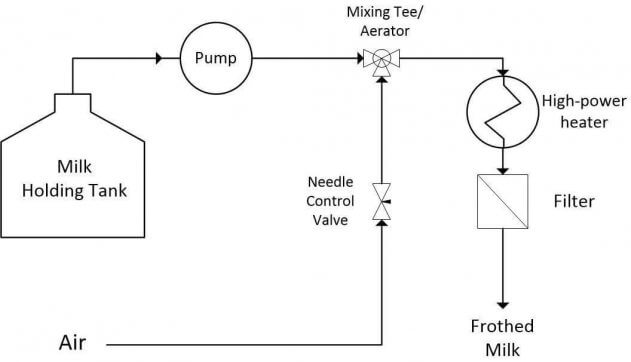
Figure 1: Ubermilk concept flow diagram. The unit runs of 230V/15amp power for a 3.1kW output. This is required to rapidly heat the milk. A 65mL total internal ‘dead-volume’ is present in the machine, 11% of a typical 600mL jug volume.
Over the last two weeks we trialled an Ubermilk unit in the Seven Miles espresso window in Sydney. We asked three of our baristas for their feedback using the unit. While generally the responses were that the unit did a great job, there are a number of considerations a café owner needs to take into account before commiting to buy one.
Integration of the Ubermilk into the barista’s workflow
The Ubermilk was easy to use, but took some time to get used to integrating it into our workflow. Once our steam-froth, muscle-memory was overcome, it was very easy to work with and we were able to get more done in the cafe. All you need to do is hit one button, like on an espresso machine, and you have the right volume of beautifully textured milk at your disposal within 7 seconds. As such, the Ubermilk made multitasking much less demanding. Ultimately, it allowed us more time to engage with customers.
In terms of enjoyment, the simple ‘push button’ operation of the Ubermilk either made the barista’s job more fun, or less fun - depending on who you asked. Those who found it more fun loved the simplicity, while those who didn’t, preferred the artistry and achievement of steaming the milk using a steam arm.
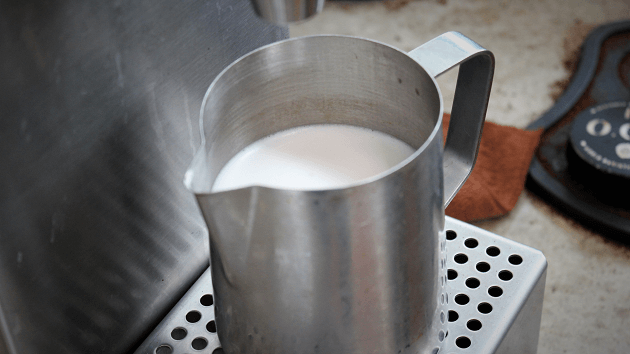
What kind of café does the Ubermilk suit?
The Ubermilk is most suitable for high volume cafes. Our espresso window is a relatively simple cafe operation. We operate with two baristas, and while we found the Ubermilk frees up about 50% of one person's time, we still require two baristas to work the café (keeping things clean, customer and table service, etc.). We would guess that the greatest value would be for cafes of 40kg/week or higher, with fewer periods of downtime. We certainly don’t see an upper limit in terms of café volume!
One of the issues we found was that at increased periods of inactivity, the unit delivered milk with a very faint ‘cooked’ flavour. This was remedied by one or two purges of the unit. So it can be avoided, but we don’t know yet how long is ‘too long’. This will be the focus of further investigations.
Is the Ubermilk suitable for speciality cafes?
The texture of the milk is fantastic, and allowed us to produce fine latte art, as shown in Figure 2.
We felt the milk tasted slightly sweeter under regular operation. Some people noticed a ‘drier’ mouthfeel when compared to traditionally-steamed, milk-based drinks.
However, most customers and baristas didn’t notice anything unusual when not told their drink was made with milk from the Ubermilk. Only a couple of comments were made about the bucket of milk in the fridge, but as we were using a sealed, food-grade container which was cleaned daily, the fears were soon put to rest.
 Figure 2: Latte-art swan poured by one of our baristas with the Ubermilk unit ‘latte’ setting milk.
Figure 2: Latte-art swan poured by one of our baristas with the Ubermilk unit ‘latte’ setting milk.
One thing we found during operation was that the foam was remarkably stable. We could leave a jug on the table for longer than we could for a traditionally steamed milk jug and rework the foam without any issue. It doesn’t ‘break’ like foam produced from a steam does. So, is this good for a speciality café? yes in terms of taste and quality. However, handling custom orders was a different story.
Limitations of the Ubermilk
The Ubermilk is very good at doing one kind of milk texture, but is a little cumbersome when changing foam levels. The technology is not yet to the point where it can distinguish between latte and cappuccino foam levels, despite the unit having specific menu items for these textures. We found that the foam level dispensed was identical on both latte and cappuccino settings, even after multiple purges, as shown in Figure 3. In real-world operation, most people don’t notice these differences in lattes/cappuccinos. However, babycinos and macchiatos required the use of steam arms to froth milk to the appropriate consistency. 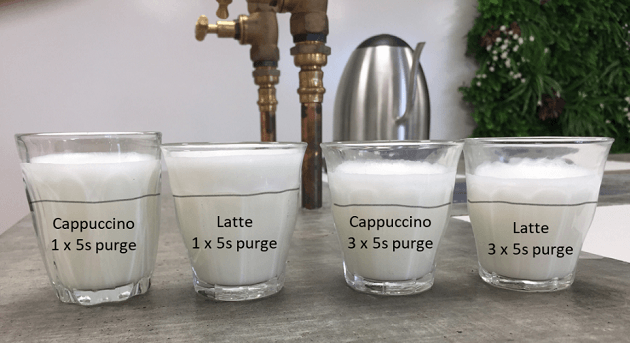
Figure 3: Ubermilk comparison between cappuccino and latte settings with different levels of purge. Very little difference is observed in the milk froth level (from the dispenser), even after multiple purges
The Ubermilk can do different quantities of foam, but you have to change the needle valve and then purge milk through the system. Ultimately we found it faster to simply steam the milk manually rather then do multiple Ubermilk valve calibrations to get foam level right. Despite this limitation, changing foam levels is simple enough by rotating a knurled handle, and then recalibrating the volume of milk dispensed. We just found it faster and less wasteful to manually steam high-foam drinks.
Another consideration is that one Ubermilk unit can only do one milk type - in our case, full-cream milk. So skim milk or soy would either require their own Ubermilk units or a barista manually steaming milk. We found that we were able to use the Ubermilk exclusively for 65-75% of our milk-based coffees, with the remainder either being ‘finished’ appropriately with a steam arm, or using only a steam arm. Another issue was preparing milk for people who wanted ‘extra hot’ lattes. The unit can only heat milk to a maximum of 68 degrees Celsius, so there were problems there, but it wasn’t hard to overcome. We first frothed on the Ubermilk and simply made the milk hotter using the espresso machine steam arm.
Does the Ubermilk replace the traditional steam arm? does the unit replace a barista?
Not unless you could afford 5 of them with the associated fridge space. We generally steamed about 30% of the drinks manually using the steam wand with one Ubermilk in place. With each additional Ubermilk you would cut down another 50% of the requirement for the steam arm, but it would be diminishing returns with each additional unit purchased. So perhaps only very high-volume cafes (greater than 60kg/wk) could justify more than one Ubermilk unit financially. The unit certainly can’t replace one barista, but it could free up half of one baristas time!
So, while there is certainly a saving in labour cost, the greater benefit in our opinion is improved efficiency (i.e. faster service) and more time with ‘eyes up’ talking to customers. This has the potential to result in something even more valuable - increased sales.
Cleaning & Maintenance
Cleaning of the Ubermilk is super easy. Almost barista proof. You use one acid-type chemical (phosphoric acid) to clean the unit one day, and then an alkaline chemical (sodium hydroxide) to clean the unit the next. It’s an automated ‘push-button’ process, which is very simple to use and hard to get wrong. The only important thing to remember is to do the clean daily, so you don’t risk your customers health and void the units warranty!!!
Conclusions
In all, the Ubermilk is a welcome bit of technology. Its ease of use and facilitation of greater barista-customer interaction makes it nearly a no-brainer for high volume cafes to implement into their workflow. We do not think the machine replaces a full barista at this point, but the value-add of freeing up 50% of one barista’s time (to work on other things, and focus on customer service) is certainly worth the price tag (circa. $11,000AUD). Whether cafes smaller than 30kg/wk can justify the cost of installing it is up to the café owner, but we’d heartily recommend the unit for cafes with volumes greater than this. In the future, we will be getting an Ubermilk unit into our testing facility at Seven Miles and pushing it to the extreme. We want to learn how easy the machine is to service, identify any issues that may cause clogging or poor operation, stagnation time issues (i.e. does milk burn in the heater after long periods of inactivity?), and other operational issues in more detail.
Until then, please let us know if you have questions, or suggestions on what sort of test you would like to see. For more on the latest cafe technology, check out our review of the Mythos 2 Grinder or our roundup of cafe automation.
